2019 TOYOTA PRIUS PLUS headlights
[x] Cancel search: headlightsPage 430 of 568
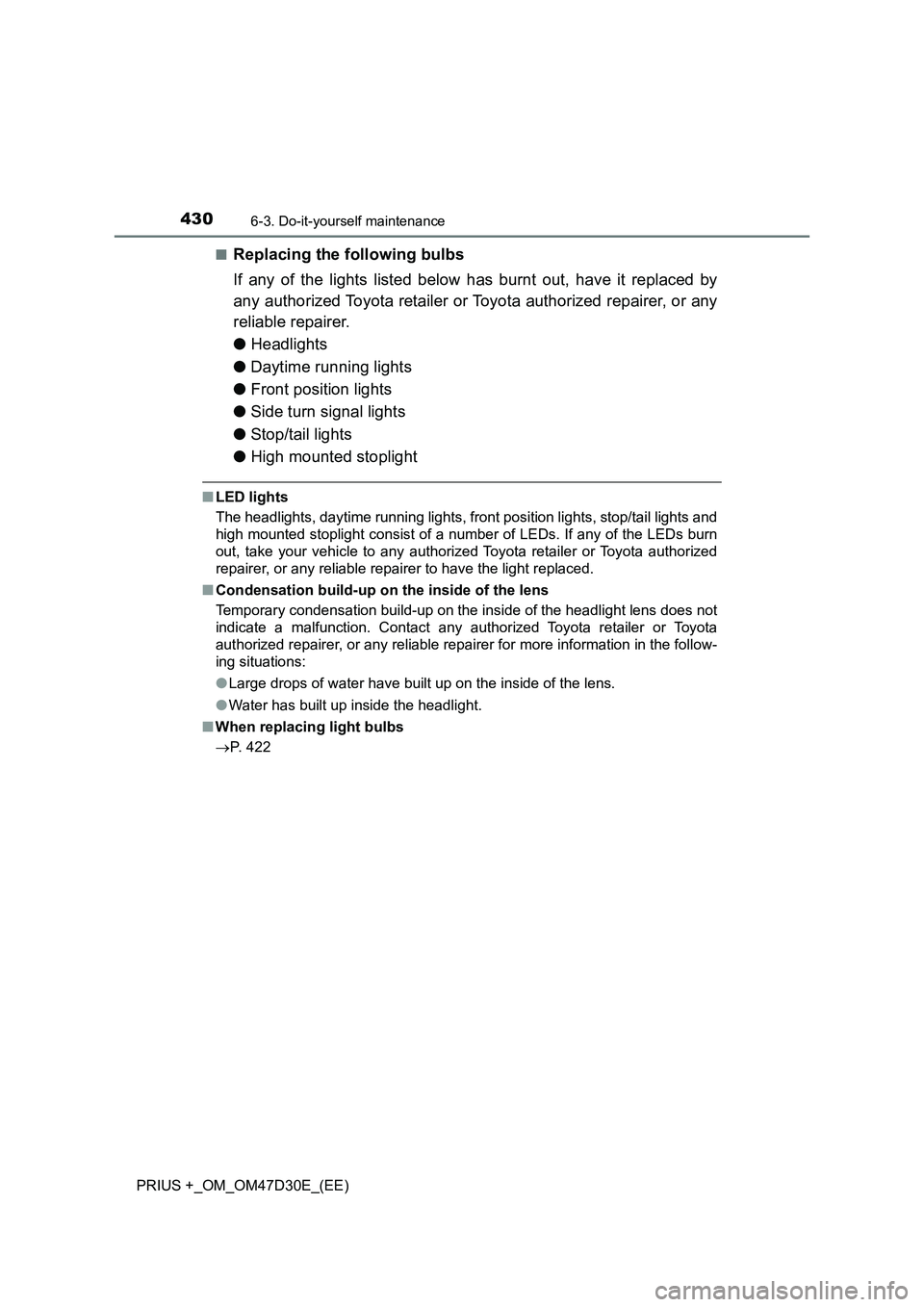
4306-3. Do-it-yourself maintenance
PRIUS +_OM_OM47D30E_(EE)■
Replacing the following bulbs
If any of the lights listed below has burnt out, have it replaced by
any authorized Toyota retailer or Toyota authorized repairer, or any
reliable repairer.
●Headlights
●Daytime running lights
●Front position lights
●Side turn signal lights
●Stop/tail lights
●High mounted stoplight
■LED lights
The headlights, daytime running lights, front position lights, stop/tail lights and
high mounted stoplight consist of a number of LEDs. If any of the LEDs burn
out, take your vehicle to any authorized Toyota retailer or Toyota authorized
repairer, or any reliable repairer to have the light replaced.
■Condensation build-up on the inside of the lens
Temporary condensation build-up on the inside of the headlight lens does not
indicate a malfunction. Contact any authorized Toyota retailer or Toyota
authorized repairer, or any reliable repairer for more information in the follow-
ing situations:
●Large drops of water have built up on the inside of the lens.
●Water has built up inside the headlight.
■When replacing light bulbs
P. 422
Page 431 of 568
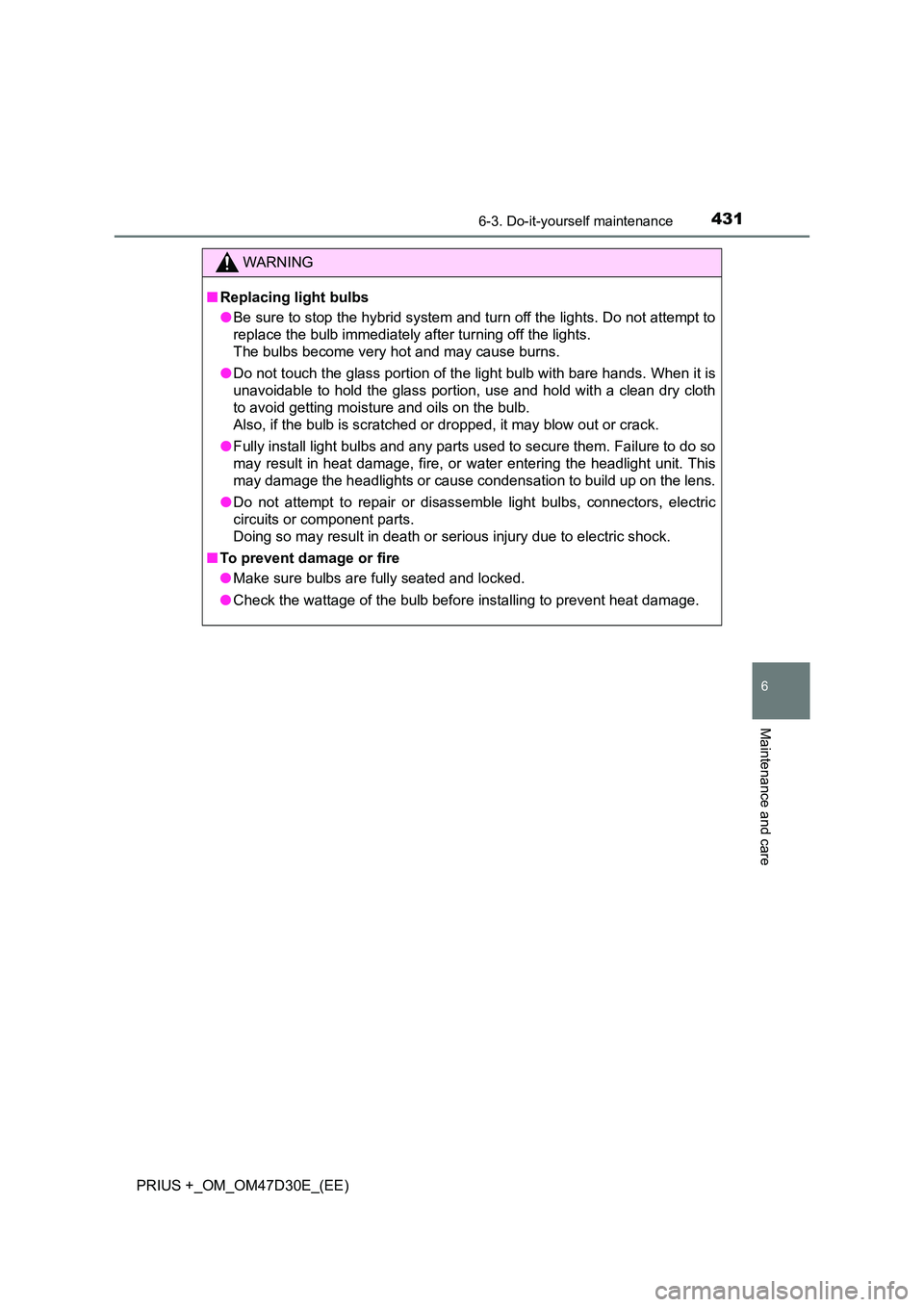
4316-3. Do-it-yourself maintenance
PRIUS +_OM_OM47D30E_(EE)
6
Maintenance and care
WARNING
■Replacing light bulbs
● Be sure to stop the hybrid system and turn off the lights. Do not attempt to
replace the bulb immediately after turning off the lights.
The bulbs become very hot and may cause burns.
● Do not touch the glass portion of the light bulb with bare hands. When it is
unavoidable to hold the glass portion, use and hold with a clean dry cloth
to avoid getting moisture and oils on the bulb.
Also, if the bulb is scratched or dropped, it may blow out or crack.
● Fully install light bulbs and any parts used to secure them. Failure to do so
may result in heat damage, fire, or water entering the headlight unit. This
may damage the headlights or cause condensation to build up on the lens.
● Do not attempt to repair or disassemble light bulbs, connectors, electric
circuits or component parts.
Doing so may result in death or serious injury due to electric shock.
■ To prevent damage or fire
● Make sure bulbs are fully seated and locked.
● Check the wattage of the bulb before installing to prevent heat damage.
Page 448 of 568

4487-2. Steps to take in an emergency
PRIUS +_OM_OM47D30E_(EE)
(If equipped)
Parking lock system warning message (warning buzzer)
Indicates a malfunction in the shift control system when
the vehicle is stopped
• In this situation, there is a possibility that the parking
lock mechanism will not work. When parking, park the
vehicle on a flat surface and apply the parking brake
securely.
• The power switch may not be turned off. If this happens,
applying the parking brake will enable the switch to be
turned off.
Have the vehicle inspected by any authorized Toyota
retailer or Toyota authorized repairer, or any reliable
repairer immediately.
(If equipped)
Hybrid battery indicator light
The hybrid battery (traction battery) will soon need to be
inspected or replaced
Have the hybrid battery (traction battery) inspected by any
authorized Toyota retailer or Toyota authorized repairer, or
any reliable repairer immediately.*2
Have the vehicle inspected by any authorized Toyota
retailer or Toyota authorized repairer, or any reliable
repairer immediately.
(If equipped)
LED headlight warning light
Indicates a malfunction in the LED headlights
The LED headlights will not normally illuminate when
there is a malfunction, however they may be able to illu-
minate depending on the nature of the problem.
Have the vehicle inspected by any authorized Toyota
retailer or Toyota authorized repairer, or any reliable
repairer immediately.
(Flashes) (If equipped)
P position request indicator light (warning buzzer)
The amount of charge remaining in the hybrid battery
(traction battery) has fallen because the shift position has
been left in N for a long time
Because recharging is not possible when the shift
position is in N, shift the shift position to P when
parking the vehicle for a long time.
• The driver’s door has been opened while the shift posi-
tion is in N, D or B
• An attempt has been made to start the hybrid system
while the shift position is in anything other than P
Shift the shift position to P.
Warning lightWarning light/Details/Actions
Page 464 of 568
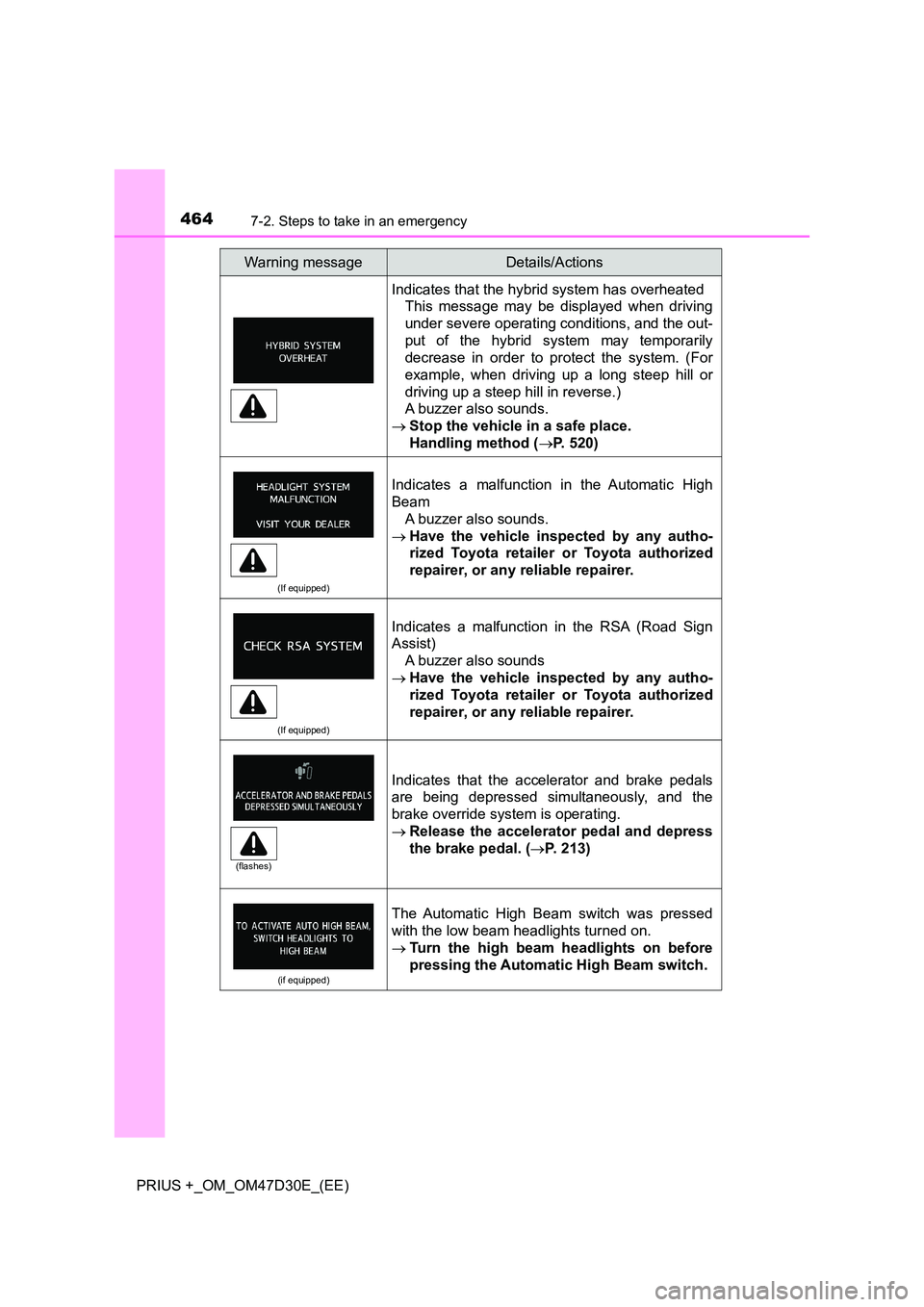
4647-2. Steps to take in an emergency
PRIUS +_OM_OM47D30E_(EE)
Indicates that the hybrid system has overheated
This message may be displayed when driving
under severe operating conditions, and the out-
put of the hybrid system may temporarily
decrease in order to protect the system. (For
example, when driving up a long steep hill or
driving up a steep hill in reverse.)
A buzzer also sounds.
Stop the vehicle in a safe place.
Handling method ( P. 520)
(If equipped)
Indicates a malfunction in the Automatic High
Beam
A buzzer also sounds.
Have the vehicle inspected by any autho-
rized Toyota retailer or Toyota authorized
repairer, or any reliable repairer.
(If equipped)
Indicates a malfunction in the RSA (Road Sign
Assist)
A buzzer also sounds
Have the vehicle inspected by any autho-
rized Toyota retailer or Toyota authorized
repairer, or any reliable repairer.
Indicates that the accelerator and brake pedals
are being depressed simultaneously, and the
brake override system is operating.
Release the accelerator pedal and depress
the brake pedal. ( P. 2 1 3 )
(if equipped)
The Automatic High Beam switch was pressed
with the low beam headlights turned on.
Turn the high beam headlights on before
pressing the Automatic High Beam switch.
Warning messageDetails/Actions
(flashes)
Page 509 of 568
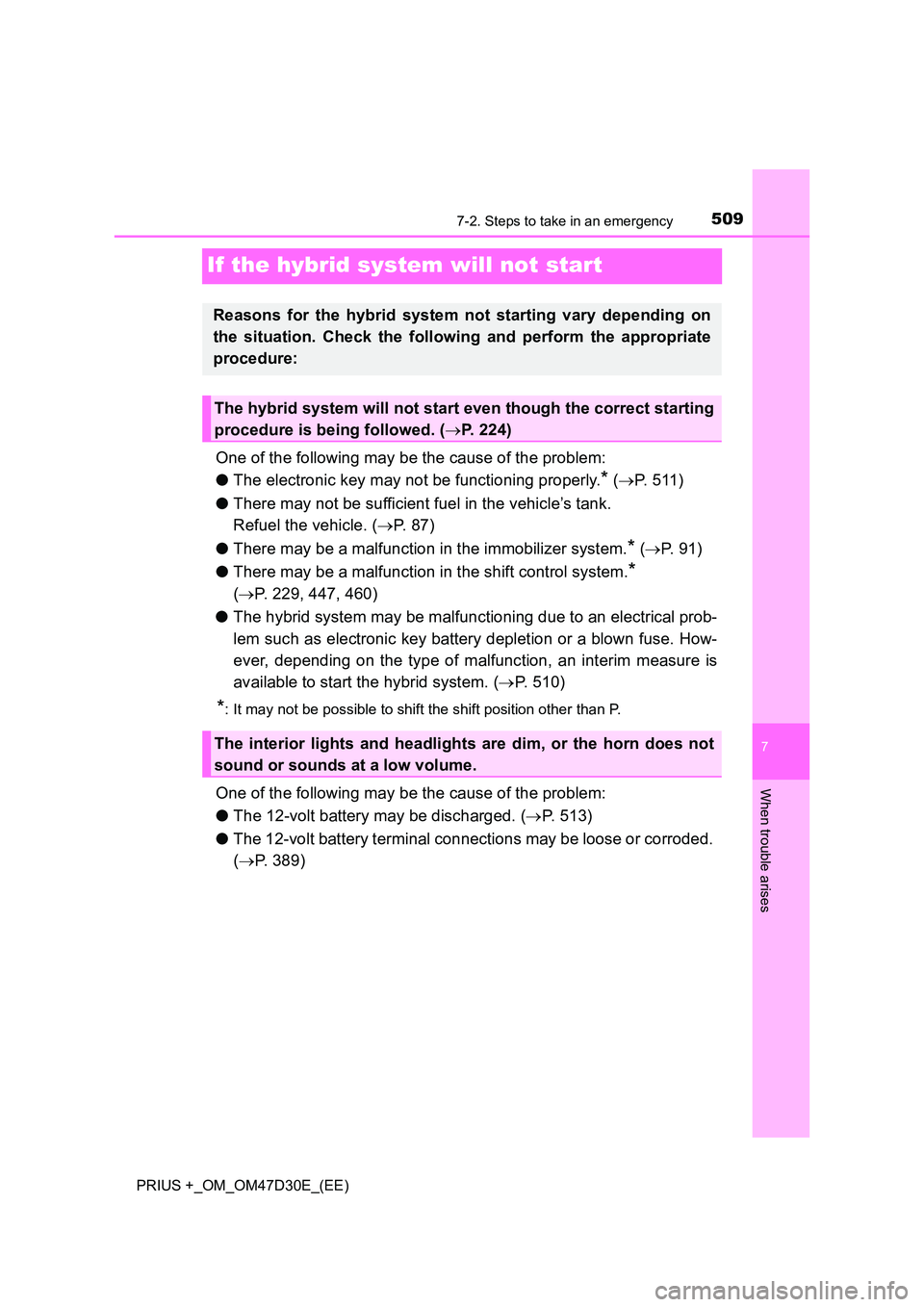
5097-2. Steps to take in an emergency
PRIUS +_OM_OM47D30E_(EE)
7
When trouble arises
If the hybrid system will not start
One of the following may be the cause of the problem:
● The electronic key may not be functioning properly.* (P. 5 1 1 )
● There may not be sufficient fuel in the vehicle’s tank.
Refuel the vehicle. ( P. 8 7 )
● There may be a malfunction in the immobilizer system.* (P. 9 1 )
● There may be a malfunction in the shift control system.*
( P. 229, 447, 460)
● The hybrid system may be malfunctioning due to an electrical prob-
lem such as electronic key battery depletion or a blown fuse. How-
ever, depending on the type of malfunction, an interim measure is
available to start the hybrid system. ( P. 510)
*: It may not be possible to shift the shift position other than P.
One of the following may be the cause of the problem:
● The 12-volt battery may be discharged. (P. 513)
● The 12-volt battery terminal connections may be loose or corroded.
( P. 389)
Reasons for the hybrid system not starting vary depending on
the situation. Check the following and perform the appropriate
procedure:
The hybrid system will not start even though the correct starting
procedure is being followed. ( P. 224)
The interior lights and headlights are dim, or the horn does not
sound or sounds at a low volume.
Page 510 of 568
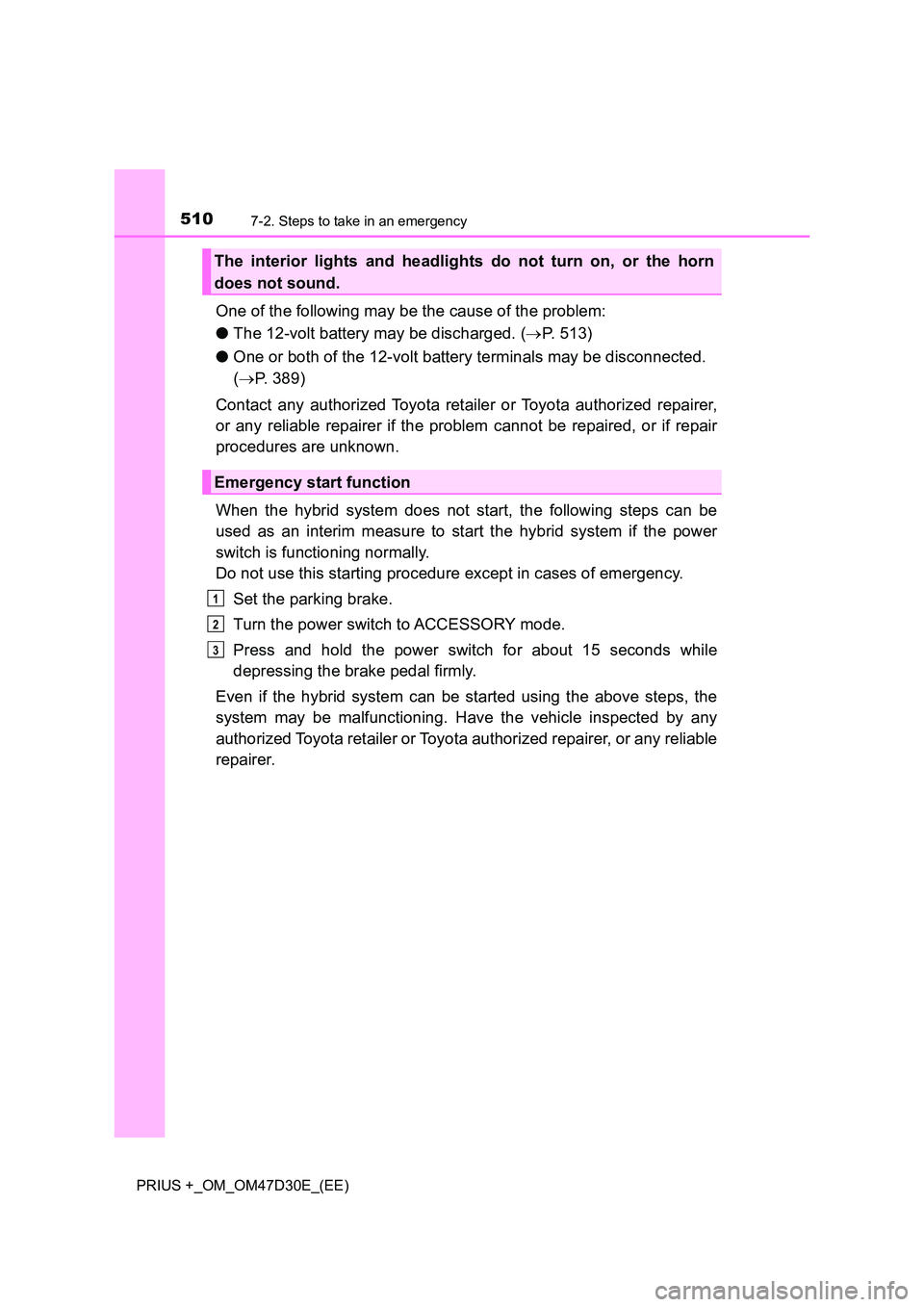
5107-2. Steps to take in an emergency
PRIUS +_OM_OM47D30E_(EE)
One of the following may be the cause of the problem:
● The 12-volt battery may be discharged. (P. 513)
● One or both of the 12-volt battery terminals may be disconnected.
( P. 389)
Contact any authorized Toyota retailer or Toyota authorized repairer,
or any reliable repairer if the problem cannot be repaired, or if repair
procedures are unknown.
When the hybrid system does not start, the following steps can be
used as an interim measure to start the hybrid system if the power
switch is functioning normally.
Do not use this starting procedure except in cases of emergency.
Set the parking brake.
Turn the power switch to ACCESSORY mode.
Press and hold the power switch for about 15 seconds while
depressing the brake pedal firmly.
Even if the hybrid system can be started using the above steps, the
system may be malfunctioning. Have the vehicle inspected by any
authorized Toyota retailer or Toyota authorized repairer, or any reliable
repairer.
The interior lights and headlights do not turn on, or the horn
does not sound.
Emergency start function
1
2
3
Page 515 of 568

5157-2. Steps to take in an emergency
PRIUS +_OM_OM47D30E_(EE)
7
When trouble arises
Start the engine of the second vehicle. Increase the engine speed
slightly and maintain at that level for approximately 5 minutes to
recharge the 12-volt battery of your vehicle.
Maintain the engine speed of the second vehicle and start the
hybrid system of your vehicle by turning the power switch to ON
mode.
Make sure the “READY” indicator comes on. If the indicator light
does not come on, contact any authorized Toyota retailer or Toyota
authorized repairer, or any reliable repairer.
Once the hybrid system has started, remove the jumper cables in
the exact reverse order from which they were connected.
Close the exclusive jump starting terminal cover, and reinstall the
fuse box cover to its original position.
When installing, first hook the fuse box cover onto the two rear tabs.
Once the hybrid system starts, have the vehicle inspected at any
authorized Toyota retailer or Toyota authorized repairer, or any reliable
repairer as soon as possible.
■ Starting the hybrid system when the 12-volt battery is discharged
The hybrid system cannot be started by push-starting.
■ To prevent 12-volt battery discharge
● Turn off the headlights and the audio system while the hybrid system is off.
● Turn off any unnecessary electrical components when the vehicle is running
at a low speed for an extended period, such as in heavy traffic.
■ When the 12-volt battery is removed or discharged
● In some cases, it may not be possible to unlock the doors using the smart
entry & start system when the 12-volt battery is discharged. Use the wire-
less remote control or the mechanical key to lock or unlock the doors.
● The hybrid system may not start on the first attempt after the 12-volt battery
has recharged but will start normally after the second attempt. This is not a
malfunction.
● The power switch mode is memorized by the vehicle. When the 12-volt bat-
tery is reconnected, the system will return to the mode it was in before the
12-volt battery was discharged. Before disconnecting the 12-volt battery,
turn the power switch off. If you are unsure what mode the power switch was
in before the 12-volt battery discharged, be especially careful when recon-
necting the 12-volt battery.
5
6
7
8
9
Page 533 of 568
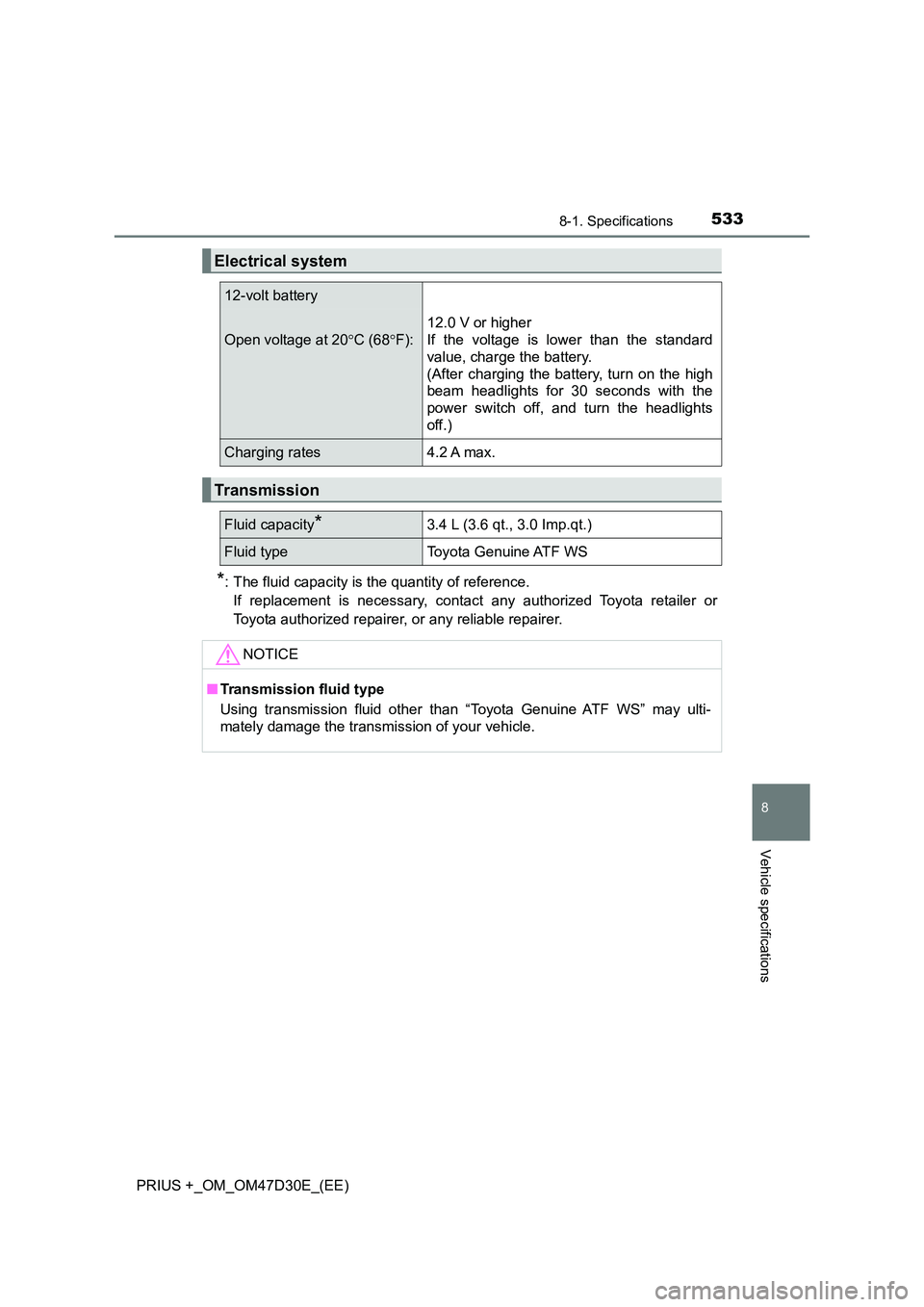
5338-1. Specifications
PRIUS +_OM_OM47D30E_(EE)
8
Vehicle specifications
*: The fluid capacity is the quantity of reference.
If replacement is necessary, contact any authorized Toyota retailer or
Toyota authorized repairer, or any reliable repairer.
Electrical system
12-volt battery
Open voltage at 20 C (68F):
12.0 V or higher
If the voltage is lower than the standard
value, charge the battery.
(After charging the battery, turn on the high
beam headlights for 30 seconds with the
power switch off, and turn the headlights
off.)
Charging rates4.2 A max.
Transmission
Fluid capacity*3.4 L (3.6 qt., 3.0 Imp.qt.)
Fluid typeToyota Genuine ATF WS
NOTICE
■ Transmission fluid type
Using transmission fluid other than “Toyota Genuine ATF WS” may ulti-
mately damage the transmission of your vehicle.